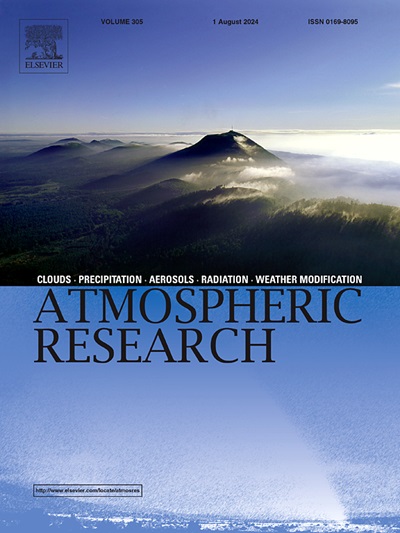Spatiotemporal variations of global precipitation concentration and potential links to flood-drought events in past 70 years
IF 4.5
2区 地球科学
Q1 METEOROLOGY & ATMOSPHERIC SCIENCES
引用次数: 0
Abstract
The evaluation of precipitation events is crucial for predicting severe droughts and floods, particularly in the context of global warming. This study presents a comprehensive spatiotemporal analysis of the global precipitation concentration index (CI) from 1950 to 2020, comparing CI with nine extreme precipitation indices to assess its applicability. The world map was divided into three distinct regions related to flood-drought events using the standardized precipitation index (SPI). Key findings include: 1) CI exhibited significant spatial heterogeneity, with elevated values in seasonally warm coastlines and arid regions. Seasonal changes in CI were not synchronized, particularly lower in Northern Hemisphere winters, while the Southern Hemisphere displayed minor seasonal variation, alongside a long-term growth trend in approximately 36.5 % of the global area. 2) CI's spatiotemporal variations helped delineating regional precipitation patterns, revealing a strong correlation (R2 = 0.87) with the extreme precipitation index R95c, but a negligible relationship with total precipitation (P) (R2 = -0.05). This facilitated the global partitioning into three regions: Humidity Amplification Region (I), Dryness Intensification Region (II), and Climate Fluctuation Region (III). 3) Flood-drought events were potentially linked to variations in CI and P, where In Region I experienced increased flood risk due to rising CI and P, Region II faced heightened drought risk from rising CI and declining P, and Region III showed opposing effects on floods due to reduced CI and increased P, with P variability significantly influencing flood frequency. 4) The main atmospheric circulation factors varied by region, typically including the Antarctic Oscillation (AAO), Atlantic Multi-decadal Oscillation (AMO) and Arctic Oscillation (AO), with AAO being most significant. This study highlights the potential of CI in improving the prediction of drought and flood risks, emphasizing the need for enhanced regional data and dynamic modeling to better assess the impacts of climate change on precipitation patterns and hydrological extremes.

近70年来全球降水浓度的时空变化及其与水旱事件的潜在联系
对降水事件的评估对于预测严重干旱和洪水至关重要,特别是在全球变暖的背景下。本文对1950 - 2020年全球降水浓度指数(CI)进行了全面的时空分析,并与9个极端降水指数进行了比较,以评估其适用性。使用标准化降水指数(SPI)将世界地图划分为三个不同的与水旱事件相关的区域。主要发现包括:1)CI具有显著的空间异质性,在季节性温暖的海岸线和干旱地区CI值较高;CI的季节变化不同步,特别是北半球冬季较低,而南半球表现出较小的季节变化,同时全球约36.5%的面积呈长期增长趋势。2) CI的时空变化有助于刻画区域降水格局,与极端降水指数R95c有较强的相关性(R2 = 0.87),但与总降水量的相关性可忽略不计(P = -0.05)。这促进了全球划分为三个区域:③水旱事件与CI和P的变化有潜在联系,其中I区由于CI和P的升高而增加了洪涝风险,II区由于CI的升高和P的降低而增加了洪涝风险,III区由于CI的降低和P的增加而对洪涝产生相反的影响,P的变率显著影响洪涝频率。4)各区域大气环流因子主要包括南极涛动(AAO)、大西洋多年代际涛动(AMO)和北极涛动(AO),其中以AAO最为显著。本研究强调了CI在改善干旱和洪水风险预测方面的潜力,强调需要加强区域数据和动态建模,以更好地评估气候变化对降水模式和水文极端事件的影响。
本文章由计算机程序翻译,如有差异,请以英文原文为准。
求助全文
约1分钟内获得全文
求助全文
来源期刊

Atmospheric Research
地学-气象与大气科学
CiteScore
9.40
自引率
10.90%
发文量
460
审稿时长
47 days
期刊介绍:
The journal publishes scientific papers (research papers, review articles, letters and notes) dealing with the part of the atmosphere where meteorological events occur. Attention is given to all processes extending from the earth surface to the tropopause, but special emphasis continues to be devoted to the physics of clouds, mesoscale meteorology and air pollution, i.e. atmospheric aerosols; microphysical processes; cloud dynamics and thermodynamics; numerical simulation, climatology, climate change and weather modification.
 求助内容:
求助内容: 应助结果提醒方式:
应助结果提醒方式:


